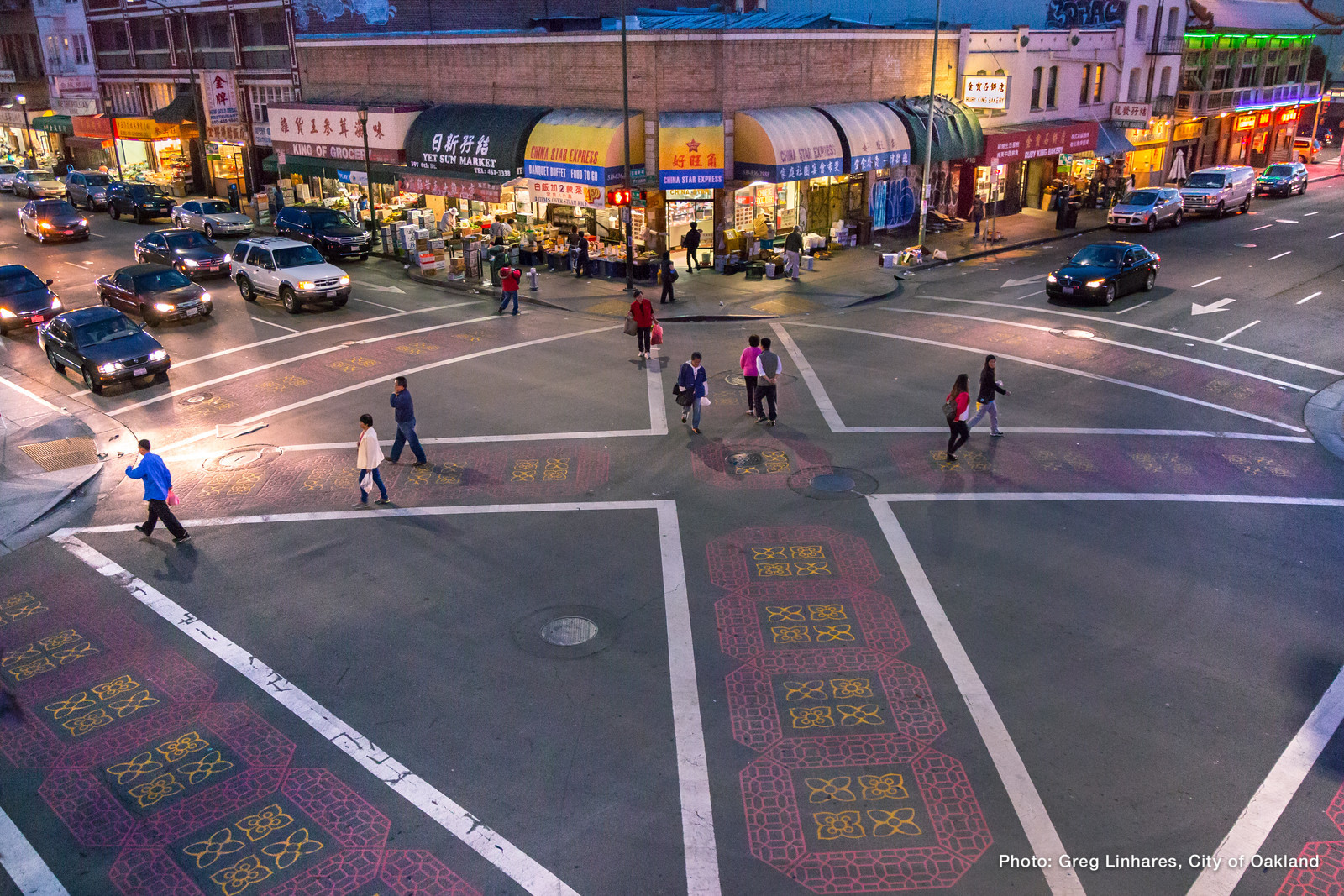WHO CRASHES IMPACT
Crashes don't impact our communities equally. Our data analysis shows that there are clear racial, geographic and age disparities in crashes. (See the "Citywide Crash Analysis" in the document section for more information and references.)
- Black Oaklanders are 2 times as likely to be killed or severely injured in a traffic crash of any type and 3 times more likely to be killed or severely injured while walking as compared to all other Oaklanders. Historic policies such as red-lining, as well as racial disparities in knowledge of government processes and how to access resources are likely to have led to these outcomes. In addition, some recent studies have found that drivers are less likely to yield to Black pedestrians than White pedestrians (Racial bias in driver yielding behavior at crosswalks, Goddard et al 2015, Transportation Research).
- Asian Oaklanders: 30% of streets in majority Asian census tracts fall on the City of Oakland Pedestrian High Injury Network - the highest percentage of any ethnicity. This disparity reflects the high concentration of "high injury corridors," or streets where severe and fatal crashes concentrate, in Chinatown, where every street is a high injury corridor.
- Older Oaklanders (65+) are more than 2 times as likely to be killed in a crash compared to all other Oaklanders; the majority of senior traffic deaths occur while walking. Seniors are especially vulnerable in crashes because our bodies are more fragile as we age, and less able to rebound or heal from a major injury.
- Younger Oaklanders (age 1-17) don't face higher rates of traffic deaths as compared to adults, however, traffic crashes are the second most common cause of death for this age group in Oakland. Homicides are the leading cause of death.
WHERE CRASHES COMMONLY TAKE PLACE
Just a few streets account for the large majority of traffic deaths and serious injuries. Together, these "high injury corridors" make up the City's high injury network, where severe and fatal traffic crashes concentrate. (See the "High Injury Network" in the document section for more information and references.)
- Just 6% of Oakland's streets account for over 60% of severe and fatal crashes across all modes
- Nearly all high injury streets are in medium- or high-ranking "Communities of Concern" a term used regionally to describe communities experiencing high rates of poverty, people of color, people with disabilities, zero car households, and English as a second language.
WHY CRASHES HAPPEN
In order to prevent crashes, we must first understand why they're happening. While traffic crashes can result from a variety of causes, some are more common than others.
- Speeding is at the root of 25% of deadly crashes in Oakland
- Oaklanders are killed or severely injured by left-turning vehicles at over 4 times the rate of right-turning vehicles
- 75% of severe or fatal injuries occur at Oakland intersections
- Drivers failing to yield to a pedestrian at a crosswalk account for over 33% of pedestrian deaths and severe injuries
WHAT WE'RE DOING ABOUT IT
Safe street design plays a critical role in encouraging safe traffic behaviors and preventing severe and fatal crashes in the first place. For a sense of the types of tools we use to increase safety, take a look at the "Crash Prevention Street Design Toolkit" in the documents section above.
We're prioritizing safety investments on the High Injury Network and in communities of concern across virtually all of our street redesign efforts at OakDOT, including:
- Safe Oakland Streets (SOS): A Comprehensive, Interdepartmental Set of Strategies to Save Lives and Advance Traffic Safety and Equity. Working in concert with the
- Capital Improvement Plan (CIP): The City's CIP outlines our major capital investments. From a transportation perspective, these are our most transformative projects that can help turn a high injury corridor into a thriving, vibrant place. In the most recent CIP, OakDOT ensured that all transportation improvements were ranked based on a number of factors that the community identified as important. Two of the highest ranking factors included equity (whether a project serves a community of concern) and safety (whether or not a project addresses a high injury corridor). OakDOT is working on dozens of projects across the High Injury Network. Some of these major projects are listed here: https://www.oaklandca.gov/resources/active-major-improvements-project
- Implementation of the Pedestrian and Bicycle Plans: The Bicycle and Pedestrian Program works to implement the City's Pedestrian and Bicycle Plans, using data driven decisions and quality street design to enhance safety.
- Prioritizing the High Injury Network in the Paving Plan: the Paving Plan touches the largest number of miles across the City of Oakland. The paving plan prioritizes strategies to reduce racial inequities and streets on the high injury network, creating a cost-effective strategy to implement striping improvements that can effectively reduce crashes.
- Safe Routes to Schools: the City of Oakland partners with the Alameda County Transportation Commission (ACTC) to deliver safety improvements around schools. ACTC plans safety improvements around schools (listed here), and OakDOT designs and delivers those improvements. In addition, OakDOT implements a school crosswalk striping program.
- Neighborhood traffic safety requests: OakDOT receives approximately 800 traffic safety requests from community members through our 311 system each year - a number that far outweighs staff capacity to investigate safety concerns and design & deliver solutions. We prioritize these requests based on crash history, equity, and proximity to schools or senior centers.
- Rapid Response Projects: while OakDOT works to proactively prevent crashes, we still face two severe or fatal crashes on average every week. When severe or fatal crashes take place that could have been prevented, OakDOT deploys crash prevention tools immediately. Examples of rapid response projects include Foothill & 22nd Ave, Foothill & 26th Ave, and Harrison & 23rd St.
